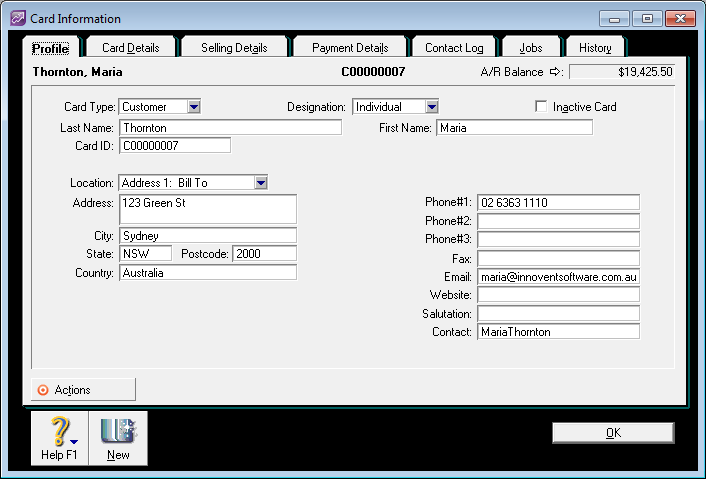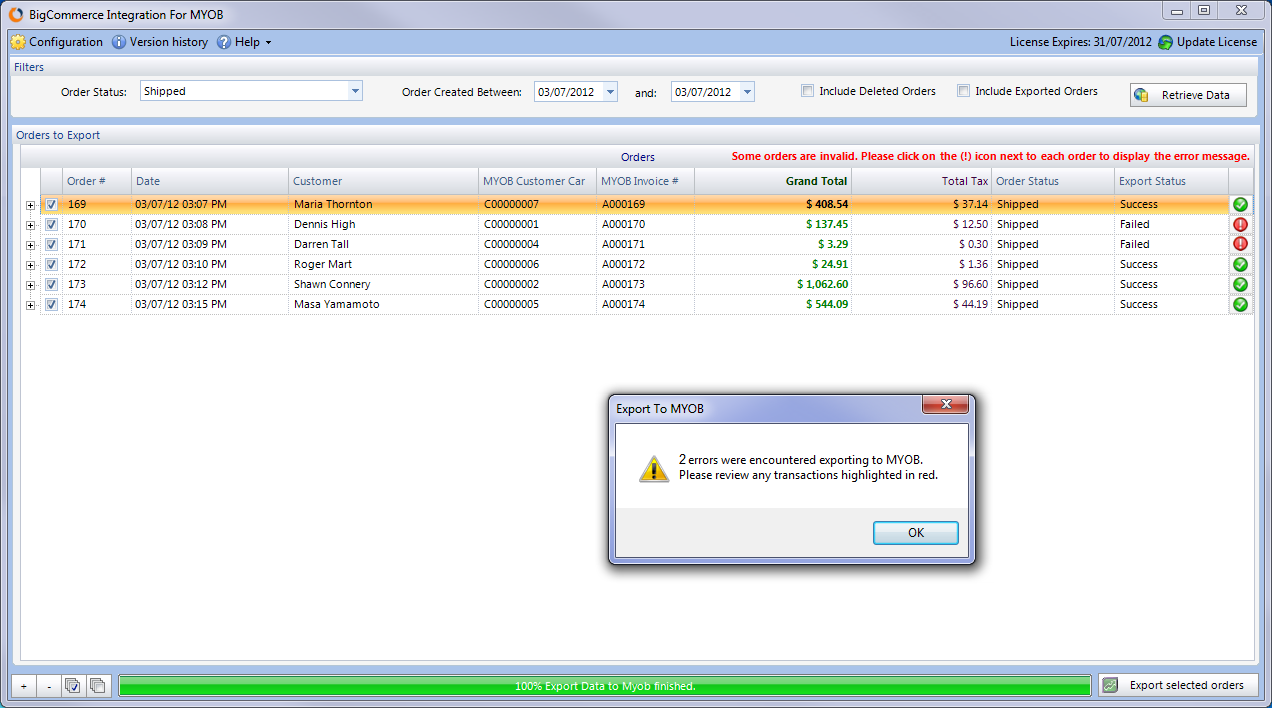To export orders into MYOB launch the Integration application and follow these steps:
- Retrieve orders from your BigCommerce shopping site. Filters will default to orders you have not exported to MYOB yet.
- Review any validation error on the order list and fix any errors before proceeding to export them to MYOB.
- Select which orders to export to MYOB from the list. The Integration will select by default all valid orders.
- Export selected orders to MYOB.
- Check for any errors after exporting.
Details on these steps are explained below:
Retrieve Orders from your BigCommerce Shopping Site
Use the Filter Section of the Main Screen to retrieve orders from your BigCommerce shopping site.

The following filters are available:
- Order Status: The Order Status as applied in BigCommerce.
- Order Created Date: A range of dates where the order was created.
- Include Deleted Orders: Enable this option if you want to include order that have been deleted from BigCommerce. Disabled by default.
- Include Exported Orders: Enable this option if you want to include orders that have been already exported to MYOB. Disabled by default. If you export an order that is already exported then it will be duplicated in MYOB. The Integration validates via the MYOB Invoice # column in the search result list and see if that invoice is present in your MYOB file. The MYOB Invoice Number value is calculated based on the the Order's Number with the rules specified in your Configuration Screen
After entering the search criteria click the Retrieve Data button to see the results.
The search results will appear in the main body of the screen:

Information seen on ever order include:
- Order #: The Order Number from BigCommerce.
- Date: The date the order was created.
- Customer: The customer's full name or "(Guest)" for guest customers.
- MYOB Customer Card ID: The Assigned Card ID for the customer as will be exported to MYOB. See the Configuration Screen on how this value is constructed.
- MYOB Invoice #: The invoice number that will be assigned to the exported sale in MYOB. See the Configuration Screen on how this value is constructed. The application looks for the invoice in your MYOB file with this value to determine whether or not this order has been exported.
- Grand Total: The Order's Grand Total (inclusive of tax).
- Total Tax: The Order's total tax.
- Export Status: Pending if the order has not been exported yet to MYOB. Exported if an invoice has been exported before (determined used the MYOB Invoice #). Success after exporting the order successfully. Failed if an export to MYOB was not successful.
To see more detailed information contained in an order click on the (+) symbol to the left of the row to expand the row.

The expanded order will reveal more detailed information:

The order details are shown in two sections:
Order Charges:
A list of non-inventory details of the order such as: shipping (freight), order handling and gift wrapping.
Columns displayed for each line contain:
- MYOB Item Number: The Item Number corresponding to either order handling or gift wrapping as specified on the Configuration Screen. These order elements will be exported to MYOB as product invoice lines. Shipping does not require an MYOB Item Number and will show as "N/A" and this element will be exported as the Freight component of the invoice.
- Description: Either Freight, Order Handling or Gift Wrapping.
- Total: Amount for the order element including tax.
- Tax Code: The MYOB Tax Code that will be used for this order element as indicated in the Configuration Screen.
- Tax: The Tax Amount for this order element.
Product Details:
The list of products being sold in this order.
Columns displayed for each line contain:
- SKU / MYOB Item Number: The product's SKU Code which will be used as the Item Number in MYOB to uniquely identify the product. Must be set for all products in BigCommerce.
- Product: The product name.
- Income Account: The GL Income Account associated with the product. Mandatory for all products in BigCommerce.
- Asset Account: The GL Asset (Inventory) Account associated with the product. Not mandatory to export sales.
- COS Account: The GL Cost of Sales Account associated with the product. Not mandatory to export sales.
- Quantity: Number of items sold.
- Sub Total: Sub total including tax before any discounts applied.
- Discount: Amount of the tax inclusive discount applied to this order line. Discounts applied from coupons or manually applied are applied to the order's lines.
- Total: Amount including tax after the discount is applied. Value is equal to Sub Total - Discount.
- Tax Code: Tax Code to be applied when exported to MYOB as set in the Configuration Screen.
- Tax Rate: Tax Rate as per coming from BigCommerce.
- Tax: Tax Amount for this line.
Review Order Validations
If you see the order highlighted in red it means that the Integration software has detected some invalid data in that order and as such cannot be exported to MYOB until the invalid data is corrected.

To see an explanation on the detected failed data click on the red exclamation mark icon that appear on the right end of the failed order.

This shows a pop-up screen with the list of errors detected for that order. Depending on the error things may have to be corrected either on the Configuration Screen of the Integration software, in BigCommerce or in your MYOB file.
In the example shown above the order shows two errors for the indicated product: it doesn't have a SKU and an Income Account. Both of them have to be corrected in BigCommerce by opening the product and completing that information. Once that is done in BigCommerce come back to the Integration screen and click the Retrieve Data button on the filter to refresh this list. The error should be gone now.
Select Orders to Export to MYOB
Only orders that are selected will be exported to MYOB. To select an order enable the tick box next to every order:

Valid orders will already be selected by default, so you will not need to select any order. If for some reason you do not want an order exported to MYOB, untick it.
At the bottom of the screen you will find a shortcut button to select all orders (
Export Orders to MYOB
Once your orders are selected click the Export Selected button located at the bottom of the screen. This will start writing your orders in MYOB as sales along with the customers cards and items involved in those orders. A progress bar will show the progress of the exporting process. Please wait until this process is finished.
If all orders are exported successfully you will see the following notification:

Note that the status of all exported orders shows the "Success" status with a green icon.
Now you should be able to find these orders in MYOB under the Sales Register.

Details of one order:

Notice how the order handling and order wrapping are exported as additional items.
You should also be able to see the new customers in your Customer Card list and the products included in these orders in your Items list.


Check for any errors after exporting
The Integration tool validates as much information in the orders as possible before exporting them to MYOB. However, there are some validations that will require to be validated at the moment of being exported. So after you click on the Export Selected Orders button you may see errors in some orders.

Similarly to validations before exporting, click on the red exclamation mark to display an explanation on what went wrong with those invoices and fix those errors before trying again.
